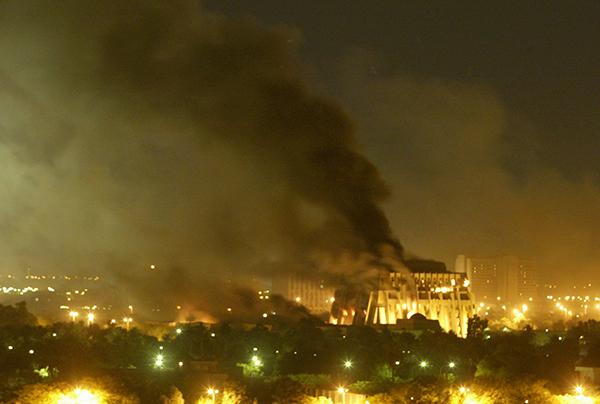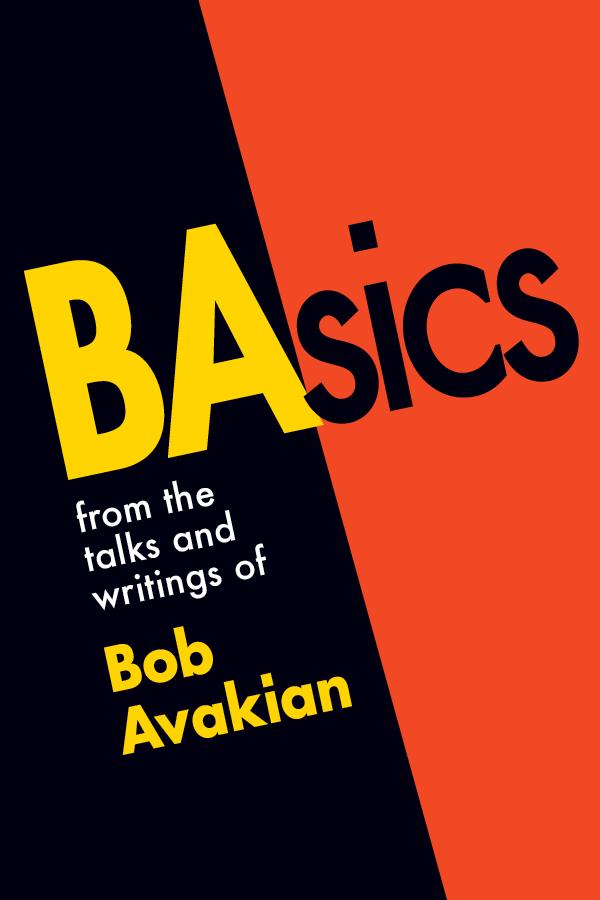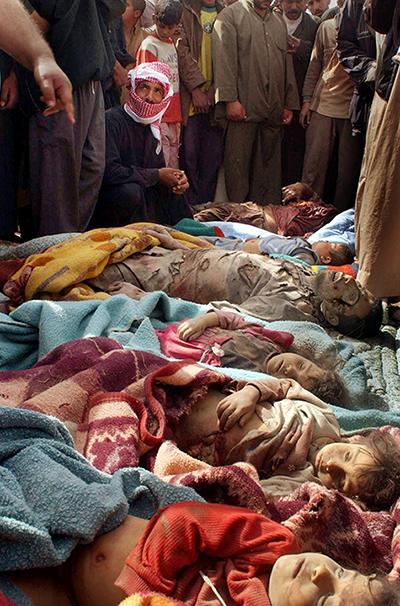Bob Avakian has written that one of three things that has “to happen in order for there to be real and lasting change for the better: People have to fully confront the actual history of this country and its role in the world up to today, and the terrible consequences of this.” (See “3 Things that have to happen in order for there to be real and lasting change for the better.”)
In that light, and in that spirit, “American Crime” is a regular feature of revcom.us. Each installment focuses on one of the 100 worst crimes committed by the U.S. rulers—out of countless bloody crimes they have carried out against people around the world, from the founding of the U.S. to the present day.
See all the articles in this series.


March 20, 2003, U.S. bombing of Baghdad, Iraq. Photo: AP
THE CRIME:
At 10:15 pm on March 19, 2003, George W. Bush announced to the world: "At this hour, American and coalition forces are in the early stages of military operations to disarm Iraq, to free its people and to defend the world from grave danger."
As Bush spoke, U.S. bombs and missiles were raining on Iraq. Some 160,000 troops—overwhelmingly American—were poised to storm the country by land. Twenty-one days later, after a blitzkrieg-like invasion and some 27,000 bombs, the U.S. had seized control of Iraq's major cities. Baghdad, Iraq's capital, had fallen on April 9. Saddam Hussein's Ba'athist regime had been deposed and the U.S. took control of the country. On May 1, standing on the deck of the aircraft carrier U.S.S. Abraham Lincoln in front of a giant "Mission Accomplished" banner, Bush declared "major combat operations" were over.
The U.S. government, military, and media portrayed this operation, with its "precision" bombs and missiles, as clean and surgical. The U.S. refused to count or release figures for civilian casualties. Images were widely broadcast picturing Iraqis welcoming the coalition forces as "liberators."
But in reality, thousands of Iraqi civilians were killed and wounded. During the most intense fighting in and around Baghdad, some of its hospitals were flooded with more than a hundred patients an hour. There were many instances of U.S. troops firing on people in cars and trucks. It turned out that U.S. military planners designated certain areas as "kill boxes"—grid-like zones where U.S. pilots were ordered to bomb and fire on anything that moved. In all, Iraq Body Count estimates that some 7,415 Iraqi civilians were killed during the invasion phase of the war in March and April.
But this was only a tiny glimpse of the staggering horrors that would be unleashed by the U.S. invasion, its nine-year occupation, and its aftermath. The U.S. shattered Hussein's Ba'athist state, and then installed a reactionary, Shi'ite-dominated regime. This unleashed all kinds of reactionary forces battling for a share of power. This included an armed Sunni-based insurgency, Sunni fundamentalist jihadists (which later formed ISIS, or the Islamic State), and Shi'ite militias with backing from Iran. The U.S. has attempted to play these different forces off against each other, and other regional powers have also entered the battle over Iraq's future.
The net result: the Iraqi people have suffered in unbelievable ways—thanks to the U.S. invasion and occupation, and all the reactionary forces and warfare it unleashed.
The toll has been staggering in its dimensions, its magnitude, and its duration. Iraq Body Count has documented between 168,239 and 187,378 civilian deaths from violence, and total violent deaths including combatants at 251,000 from 2003 through September 2016. Other studies of the direct and indirect toll of the war (due, for example, to the destruction and disruption to water and power systems, health care and food production): 655,000 according to a 2006 Lancet study; 1 million according to a 2008 Opinion Research Business study; and other current estimates reaching 1.2 to 1.4 million. More than 4.2 million Iraqis have been injured and at least 4.5 million have been driven from their homes. Women have suffered terribly, directly from the war and from the new, U.S.-backed government's imposition of reactionary Sharia law with separate, unequal laws for women.
And this reactionary violence by different Iraqi forces, as well as by the U.S., continues to this day. In October 2016 alone, at least 5,561 people were killed and 2,463 were wounded across Iraq—a heart-rending count that barely merits coverage in the U.S. press.


BAsics from the talks and writings of Bob Avakian
What we see in contention here with Jihad [Islamic fundamentalism] on the one hand and McWorld/McCrusade [increasingly globalized western imperialism] on the other hand, are historically outmoded strata among colonized and oppressed humanity up against historically outmoded ruling strata of the imperialist system. These two reactionary poles reinforce each other, even while opposing each other. If you side with either of these "outmodeds," you end up strengthening both.
While this is a very important formulation and is crucial to understanding much of the dynamics driving things in the world in this period, at the same time we do have to be clear about which of these "historically outmodeds" has done the greater damage and poses the greater threat to humanity: It is the historically outmoded ruling strata of the imperialist system, and in particular the U.S. imperialists.
—Bob Avakian, BAsics 1:28
THE CRIMINALS:
Bush administration: President George W. Bush, Vice President Dick Cheney, Secretary of State Colin Powell, National Security Adviser Condoleezza Rice, Secretary of Defense Donald Rumsfeld, Assistant Defense Secretary Paul Wolfowitz, and all arms of the U.S. government.
The Bush administration began debating war on Iraq within hours of the attacks of September 11, 2001. By late October or early November 2001, top Bush officials had secretly decided to wage war on Iraq. Reportedly, by April 2002 they had likely decided on a massive assault to remove Hussein.
In October 2001, the Pentagon set up a new intelligence/operations arm—the Office of Special Plans—to slant, spin, and concoct "intelligence" to justify war. Vice President Cheney pushed the CIA to produce reports that Iraq had chemical, biological, and nuclear weapons of mass destruction (WMD) and ties to Al Qaeda.
What followed was a 17-month deluge of lies and propaganda claiming Saddam Hussein was linked to Al Qaeda and 9/11 and that his possession of dangerous chemical, biological, and possibly nuclear weapons posed a "grave and growing danger" to the Middle East and to the United States itself. The administration also smeared and attacked those, like former Ambassador Joseph Wilson, who attempted to expose their lies.
Democratic Party: The ruling class, including Republicans, former government officials, and establishment "experts," all supported the Iraq war and repeated Bush administration claims. So did the leadership and overwhelming majority of Democrats in Congress, including Hillary Clinton and Joe Biden. (During the 1990s, the Democrats and the Bill Clinton administration had bombed, sanctioned, and supported overthrowing Hussein, helping pave the way for the 2003 invasion.)
U.S. Media: The U.S. media repeated and promoted the Bush regime's lies and cheer-led the war. It never seriously questioned the war's legality or legitimacy. During the war all major media outlets agreed to "embed" with U.S. military units on Pentagon terms, and refused to seriously question U.S. motives for the war, or the military's war crimes. They widely promoted U.S.-orchestrated photo ops like the tearing down of Saddam Hussein's statue to give the impression that all Iraqis welcomed the invasion. The New York Times played a particularly criminal role, prominently featuring articles by their correspondent Judith Miller, who was closely tied to the Bush regime, and repeated its fabrications about Iraqi WMD. When the Bush administration's WMD claims were exposed as completely baseless, the government and the media spun and covered it up as an "intelligence failure."
THE ALIBI:
The U.S. claimed that Hussein's government had ties to Al Qaeda and was involved in the attacks on 9/11. It also argued that Saddam Hussein must immediately be disarmed because his regime possessed chemical, biological, and nuclear weapons that posed a grave and immediate danger, including a nuclear attack on the U.S. Secretary of State Rice warned there would always be some uncertainty about the progress of Hussein's nuclear program, but "we don't want the smoking gun [of evidence] to be a mushroom cloud."
In Bush's January 2003 State of the Union speech, and then in Colin Powell's February 5 performance at the United Nations, the administration presented what they claimed was specific evidence of Iraq's massive WMD programs. Bush warned that Saddam Hussein had or could have "biological weapons materials which could be sufficient to produce over 25,000 liters of anthrax; enough doses to kill several million people." He repeated similar terrifying claims concerning botulinum toxin—"enough to subject millions of people to death by respiratory failure"—as well as sarin, mustard gas, and VX nerve agent. He claimed that during the 1990s, the Hussein regime had "an advanced nuclear weapons development program," and that now "The British government has learned that Saddam Hussein recently sought significant quantities of uranium from Africa," raising the specter that Hussein was building a nuclear bomb.
The Bush administration also claimed it invaded to "free the Iraqi people." "We come to Iraq with respect for its citizens, for their great civilization and for the religious faiths they practice," Bush II declared the night the war began. "We have no ambition in Iraq, except to remove a threat and restore control of that country to its own people."
The U.S. also claimed it was invading Iraq to end Saddam Hussein's imprisoning and torture of his opponents, as well as the massacres he carried out against Shi'ites, but especially against Iraq's Kurds. Hussein was a reactionary, pro-imperialist tyrant who did imprison, torture, and in some instances massacre his opponents. But after the U.S. had invaded and occupied Iraq, it took over a number of Iraqi prisons, including at Abu Ghraib, and massively imprisoned—and tortured—those it suspected of opposing the occupation. It was only thanks to whistleblowers that the savage torture at Abu Ghraib was exposed to the world. Even then the U.S. government and media tried to minimize the scope and horror of this. The U.S. also carried out its own massacres against the Iraqi people, for example during the November 2004 assault which laid waste to the city of Fallujah, reducing a city of 300,000 to rubble and killing both insurgents and non-combatants. (See "American Crime Case #94: November 2004—War Crime Fallujah.")
THE ACTUAL MOTIVE:
During the 1980s, the Hussein regime did produce chemical and biological weapons (with Western support) and used them against Iranian forces during the 1980-1988 Iran-Iraq war, as well as against Iraq's Kurdish people, most infamously at Halabja in 1988. Iraq also had a secret nuclear weapons program.
But by the late 1990s, the U.S. knew that Hussein had been forced by the 1991 Persian Gulf War and U.S.-United Nations sanctions to dismantle his WMD programs, as the UN concluded in 1998. In September 2002, the Defense Intelligence Agency concluded that there was "no definitive, reliable information" that Iraq either possessed or was manufacturing chemical or biological weapons. In the months right before the war, top Iraqi officials confirmed to the U.S. and Britain that Iraq had no WMD, and UN inspectors went to Iraq and found no WMD. In early 2002, the New York Times reported the CIA had "no evidence that Iraq has engaged in terrorist operations against the United States in nearly a decade, and that President Saddam Hussein has not provided chemical or biological weapons to Al Qaeda or related terrorist groups."
After the 2003 war, a team of 1,400 U.S. and British experts scoured Iraq for banned weapons. After four months of searching, none were found. The failure to find any chemical, biological, or nuclear weapons or prohibited missiles showed not only that the Bush regime was blatantly and consciously lying but that the U.S. had been lying about Iraq's purported WMD for nearly a decade.
Because Iraq had neither attacked nor posed any threat to the U.S., and because the U.S. failed to secure UN Security Council authorization for its invasion, the 2003 war on Iraq violated the UN Charter, the Geneva Conventions, as well as U.S. law, making it a war crime under U.S. and international law.
What were the U.S.'s real motives? The U.S. rulers had been shocked by the 9/11 attacks, and summed up that anti-U.S. Islamist jihadism, as well as other regional and global changes, represented major threats to U.S. domination of the Middle East, and to its global hegemony, demanding an aggressive multi-pronged response. The Bush team felt compelled to quickly and massively lash back, first by attacking Afghanistan and then by invading Iraq. This was designed to preserve the U.S. empire's global military credibility and to establish its prerogative to depose regimes around the world as it saw fit.
During a secret November 2001 meeting, as reported by Bob Woodward in State of Denial: Bush at War, Part III, leading strategists close to the Bush administration argued that the 9/11 attacks required a "two-generation battle" to defeat "radical Islam." One dimension was to quickly take down regimes in Iraq, Iran, and Syria that were contributing to the spread of anti-U.S. fundamentalism or that posed obstacles to the U.S. The Bush strategists thought this would open the door to transforming the entire region—"draining the swamp," as Rumsfeld and Wolfowitz put it shortly after September 11—to transforming the conditions giving rise to jihadism, as well as solidifying U.S. control. The participants concluded the U.S. couldn't defeat Islamic radicalism without first overthrowing Saddam Hussein.
The U.S. planned to turn Iraq into a launching pad for the restructuring of the entire Middle East. After the invasion, the Bush team attempted to quickly and radically reshape Iraqi politics, economics, and society in line with this overall vision. The invasion of Iraq was part of an ensemble of actions undertaken to solidify U.S. control of the arc from North Africa through the Middle East to Central Asia. These goals in turn were linked to a larger goal of locking in American global hegemony against rising rivals like Russia and China. None of this had anything to do with "liberating" the Iraqi people.
SOURCES:
Iraq: The Human Cost, MIT Center for Human Studies
Casualties of the Iraq War, Wikipedia
"Ten Years After U.S. Invasion of Iraq: A War Based on Lies... And a History of Brutal Intervention," revcom.us/Revolution, April 7, 2013
"The U.S. Legacy 10 Years After Invading Iraq: Death, Disease, Devastation, Displacement," revcom.us/Revolution, March 31, 2013
Larry Everest, Oil, Power and Empire: Iraq and the U.S. Global Agenda, Common Courage Press, 2004
Andrew J. Bacevich, America’s War For the Greater Middle East - A Military History

